37 light mirrors and lenses worksheet answers
The optical Bench Worksheet Answers to the mirror math problems from the book Answers to 18, 29, 31,32,42 Answers to Lenses book problems Ray Tracing for lenses Mirror Ray Tracing Worksheet Answers Answers to the extra mirror problems worksheet. The lenses which feel thicker. Find answers, download updates, schedule repair or chat with a ...
2. A point object is placed in front of a plane mirror. Which is the correct location of the image produced by the mirror? (A)A (B) B (C) C (D) D (E) E 3. A narrow beam of light is incident on the surface of a plane mirror. The initial angle between the incident ray and reflected ray is 2α.
Place a curved mirror into the light rays and observe what happens. Try moving the mirror around and observe. Flip the mirror so the curvature is in the opposite direction. Change to the other curved mirror and repeat. Repeat using the concave and convex lenses. Use the flat mirror and reflect the light at 90 degrees.
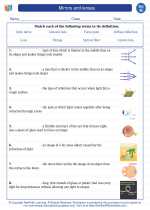
Light mirrors and lenses worksheet answers
Lights, Mirrors, Lenses! Study Guide worksheet with answer key. 25 terms on topics of: light sources, mirrors, lenses, the human eye, and light technologies. Good companion worksheet to a textbook chapter on Light technologies in our world today. Good review sheet for a quiz also. Applicable to Phy...
Lenses refraction refractive index total internal reflection worksheets and answers. Multiple choices questions quizzes with answers light reflection and refraction. Some of the worksheets for this concept are lenses work mirrors and lenses mirrors and lenses diverging converging lens work name box score date ap physics work 14 chapter 24 grade ...
SNC 2D - Light and Geometric Optics CONVEX MIRRORS Extra Practice Worksheet a) Draw a ray diagram for each to locate the image. b) State the characteristics (SALT). *note- diagrams are not to scale S A L T: 1) 2) 3)
Light mirrors and lenses worksheet answers.
QUIZ - 11.7 & 11.9 (Images in Plane Mirror & Images in Curved Mirrors) 12.7- Phenomena Related to Refraction (p. 535 - 539) * Student Handout (Read lesson 12.7 and fill in the blanks on handout, as well as assigned textbook questions)
For convex spherical mirrors and diverging lenses, f < 0 and the image is always virtual, d i < 0. Both for spherical mirrors and for lenses, the mirror-lens equations 1 𝑓 = 1 𝑑𝑜 + 1 𝑑𝑖 holds. The ratio of the heights of the image and object is magnification defined as 𝑚= ℎ𝑖 ℎ𝑜 =− 𝑑𝑖 𝑑𝑜.
_____lens is present in human eye. A _____ lens always forms an erect, virtual and diminished image. Question 2 Answer the following questions - Differentiate between the following (3 points each) a) Concave and convex mirror. b) Real and virtual image. Define a) Mirror b) lens c) prism d) rainbow e) lateral inversion
Mirrors and lenses. The reflection of light can occur in different ways. Since a mirror has a very smooth surface, all the light bouncing off of a mirror reflects in a regular manner. Read More... Science Worksheets and Study Guides Eighth Grade. Mirrors and lenses. NewPath Learning resources are fully aligned to US Education Standards.
The MCQ on Spherical Mirrors for the subject Physics is given with answers. Spherical Mirrors Multiple Choice Questions (MCQ) given in this article are useful for engineering and other graduate students for Physics subject exam preparation.
ID: 1619395 Language: English School subject: Science Grade/level: Grade 7 Age: 11-13 Main content: Light Other contents: Mirrors and lenses Add to my workbooks (8) Download file pdf Embed in my website or blog Add to Google Classroom
Lens Equations/ Math Technology and applications - Google Doc Presentation: Brief slide show on your topic (due Wed Nov 16) 3-5 slides (use images to enhance your slides as appropriate)
a curved mirror that reflects the light from a bright source. Science Journal Describe how you use mirrors and lenses during a typical day. Light waves can be absorbed, reflected, and transmitted by matter. SECTION 1 Properties of Light Main Idea A source of light gives off light rays that travel outward in all directions. SECTION 2 Reflection ...
Lights, Mirrors, Lenses! Crossword puzzle with answer key. 25 terms on topics of: light sources, mirrors, lenses, the human eye, and light technologies. Good companion worksheet to a textbook chapter on Light technologies in our world today. Good review sheet for a quiz also.
Lenses and Mirrors Activity. After using reference materials to answer questions about lenses and mirrors, students will label each shape as convex or concave. In this science printable, students will also define hyperopia and myopia and identify the type of lens used to correct each condition.
When reflected light comes in contact with your eye, the cone cells in your retina send . signals. to your brain. 2. The color that an object appears to be dependent, in part, on the wavelengths. of the light shining on it. 3. White. light is a combination of light of many different colors. Name Date Class LESSON 3. Mirrors, Lenses, and the Eye ...
Mirrors Answers April 17th 2019 Ray Tracing Mirrors Gizmo Answers Light Reflection And Mirrors Answers Optical Section 1 Mirrors Answers Problemchapter 3 3 1 review and reinforcement document. On this page you can read or download 3 1 page 11 chapter 3 3 1 review and reinforcement in PDF
PDF Light Mirrors And Lenses Answers weaker titles that will inevitably find their way onto open publishing platforms (though a book has to be really quite poor to receive less than four stars). Light Mirrors And Lenses Answers A light ray, travelling parallel to a concave lens' axis and strikes the lens, will refract and _____. answer choices ...
b. of the shape of the lens c. not all light bends as it travels through the glass d. light is a particle not a wave and therefore does not refract 10. Identify the list below that contains items that diverge light rays. a. Convex mirror and concave lens b. Convex lens and concave mirror c. Convex mirror and concave mirror d. Convex lens and ...
Light online worksheet for 5. You can do the exercises online or download the worksheet as pdf.
Lecture 37: Lenses and mirrors •Spherical lenses: converging, diverging •Plane mirrors •Spherical mirrors: concave, convex The animated ray diagrams were created by Dr. Alan Pringle. • object distance s, positive • image distance s' , • positive if image is on side of outgoing light, i.e. same side of mirror,
Chapter 15 Mirrors and Lenses. Section 1 Mirrors. A. Light is necessary for eyes to see. 1. Light waves spread in all directions from a light. 2. The brain interprets light waves as traveling in a straight line. B. Plane mirror —flat, smooth mirror. 1. Light strikes an object and is reflected off the object to the mirror and then back to the ...
Start studying Section 1-2 Reinforcement- Sound, Light, Mirrors, and Lenses- Sykes. Learn vocabulary, terms, and more with flashcards, games, and other study tools.
Light waves reflect off of mirrors to form images. o An image that appears to be behind the mirror is virtual o An image formed in front of the mirror is real The curvature of a mirror is defined by its radius of curvature. ½ of the radius of curvature is called the focal length or focal distance. o 1 2 𝑅=𝑓
17. The image formed on the film in a camera and on the retina of your eye is _____. 18. A _____ uses large mirrors to bring distant objects into closer view. 19. If you are standing 4 feet from a plane mirror and looking into it, the image you see will be ______ feet away from the mirror on the other side. 20.
The mirror and the lens are likely to be a) the mirror is concave and the lens is convex b) both concave c) the mirror is convex but the lens is concave d) both convex. 3. In this question, two statements are given- one labelled Assertion (A) and the other labelled Reason (R). Select the correct answer to these questions from the codes (a), (b ...
mirrors. 18.1 Mirrors 416 Mirrors and Lenses O Mirror I θ θ FIGURE 18-1 The reflected rays that enter the eye appear to origi-nate at a point behind the mirror. Color Conventions • Light rays are red. • Lenses and mirrors are light blue. • Objects are indigo. • Images are light violet.
Answer: A. The problem of spherical aberration are caused by the inability of the outer portions of a concave spherical mirror to reflect and focus light to the same image locations as other portions of the mirror. A cure for the problem involves the use of a mirror with a different shape in the regions far from the principal axis; a parabolic ...



(91).jpg)
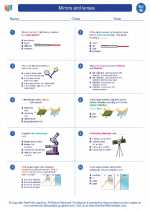









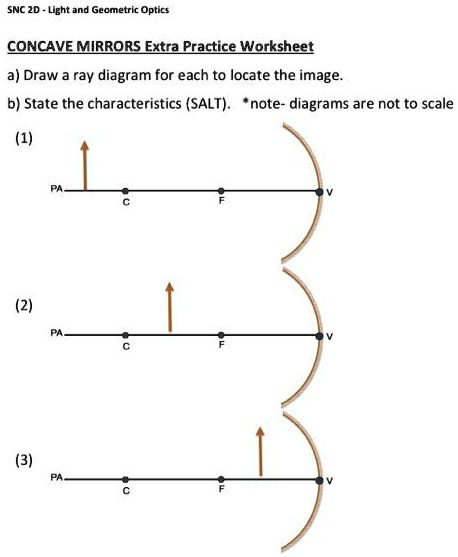


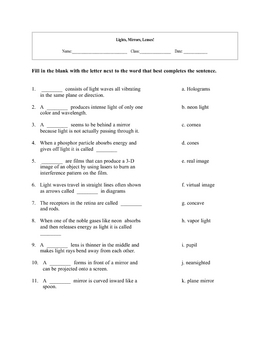

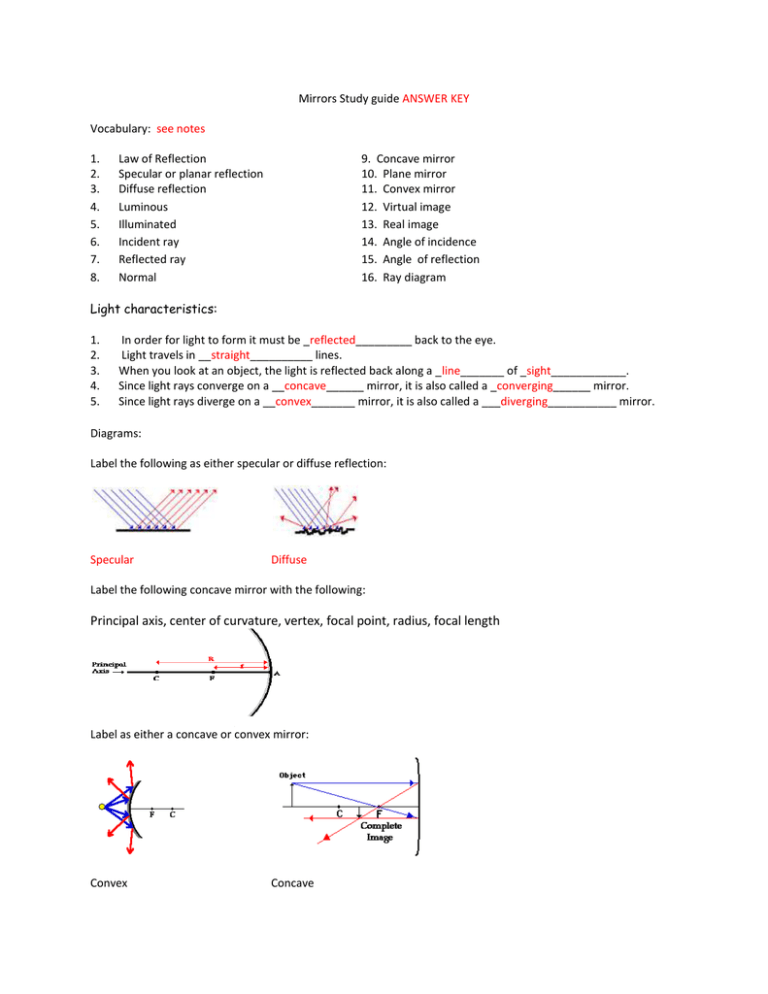








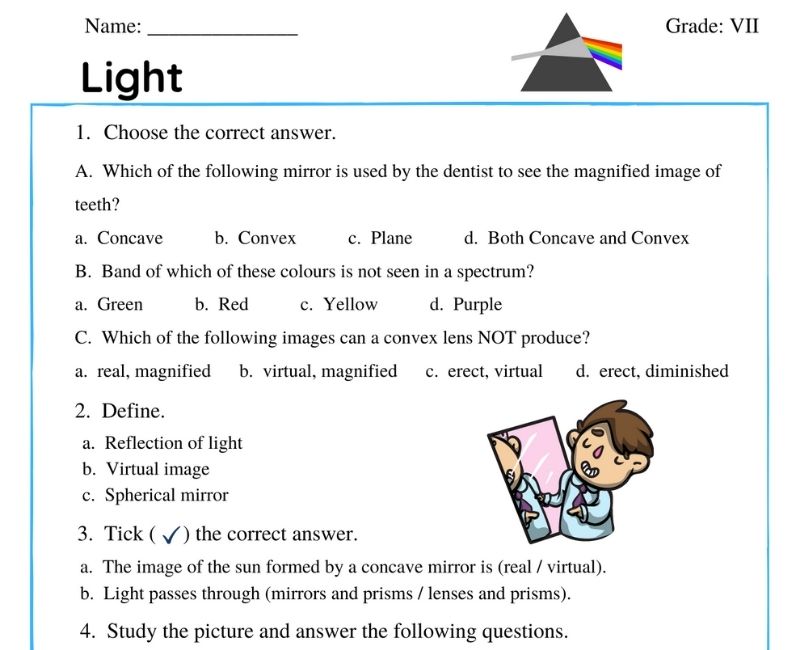

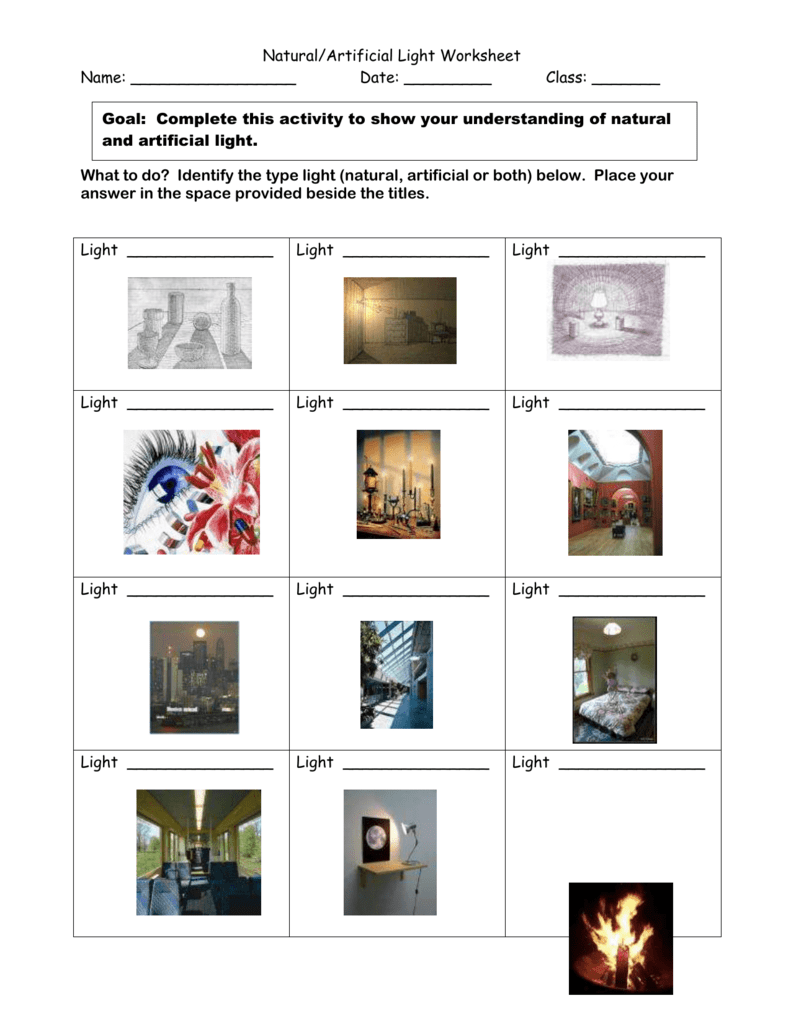



0 Response to "37 light mirrors and lenses worksheet answers"
Post a Comment